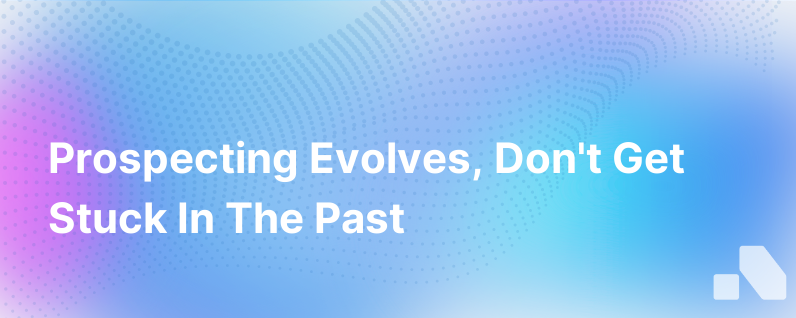Buying Has Changed But Prospecting Is Stuck In The Past
Published on November 4, 2023 by Sawyer Middeleer
In the age of digital transformation and rapidly evolving markets, buying behaviors have drastically changed. The modern buyer is well-informed, technologically savvy, and has access to a world of information at their fingertips. Yet, surprisingly, many sales organizations continue to prospect in ways that are reminiscent of strategies developed decades ago. The dissonance between modern buying processes and outdated prospecting methods is stark and warrants a closer examination.
The Evolution of Buying Behaviors
Let's address the sea of change that has occurred in buyer behavior. The contemporary buyer journey is a complex labyrinth that rarely follows a linear path. Buyers now research extensively online before making a purchasing decision, utilizing a myriad of resources from articles and reviews to social proof on platforms like LinkedIn.
Their expectations have risen; they demand relevance, personalization, and value-driven interactions. They are less tolerant of generic sales pitches and more likely to engage with sellers who exhibit a deep understanding of their unique challenges and who offer tailor-made solutions.
Why Prospecting Is Failing to Keep Up
Despite this paradigm shift, prospecting methodologies often remain mired in past practices. The traditional playbook, which emphasizes volume – more calls, more emails, more touchpoints – is not only ineffective but can be detrimental to building long-term customer relationships.
-
One-Size-Fits-All Communication: Mass-broadcasted messages that fail to address the specific needs of a prospect are increasingly ineffective. Today's buyers expect communication that is personalized and relevant to their industry, company, and even their role within the company.
-
Dependence on Cold Outreach: Cold calls and emails are becoming less effective as buyers are inundated with information. They now prefer warm introductions or interactions with salespeople who have clearly done their homework.
-
Underestimating the Educated Buyer: Salespeople stuck in old prospecting mindsets underestimate how educated buyers are today. With a wealth of information available to them, prospects are often steps ahead in the sales process before even engaging with a sales representative.
-
Lack of Social Selling: Prospecting efforts often neglect the platforms where buyers are actively seeking information and engaging in professional communities, like LinkedIn and industry forums.
Aligning Prospecting with the Modern Buyer
Adapting to the modern buyer means fundamentally transforming prospecting strategies:
Research and Relevance
In-depth research is indispensable. This goes beyond just knowing the name, title, and industry of the prospect. Understanding the company's current initiatives, challenges faced by their industry, and the specific pain points of the prospect's role can differentiate a salesperson in a crowded market.
Leveraging Data Analytics
Advanced data analytics and AI offer predictive insights into buying behaviors and preferences. Sales teams that incorporate these tools into their prospecting strategies can identify high-potential leads and personalize engagement based on sophisticated customer data.
Building Relationships through Social Selling
Social selling – using social networks to find, connect with, educate, and nurture sales prospects – aligns with the ways buyers now consume information and make purchasing decisions. Developing a strong, reputable online presence and engaging with potential clients on these platforms can lead to warmer leads and better sales conversations.
Educating and Adding Value
Informational content that educates prospects about industry trends, solutions to their pain points, and offers actionable insights is far more valued than a direct sales pitch. By becoming a trusted advisor, salespeople can greatly increase the chances of turning a prospect into a customer.
Tightening Feedback Loops
There is much to be learned from interactions with prospects, whether successful or not. Continuous learning from these engagements and adjusting tactics accordingly is crucial for sales teams to stay relevant and successful.
Aomni: Bringing Prospecting into the Future
If prospecting is stuck in the past, how do we catapult it into the present? Aomni's AI platform offers a solution by transforming the prospecting process for B2B sales. It delivers meticulous account research, competitive insights, and sales content tailored to the modern buyer – all in 15 minutes and with negligible effort required from the sales team.
Aomni ensures every interaction with a prospect is informed by real-time data, personalized to address their current business needs, and enriched with actionable competitive insights. This is the future of prospecting: intelligent, precise, and responsive to the evolved buying landscape.
In Conclusion
As buying behaviors continue to evolve, the gap between progressive purchasing processes and antiquated prospecting techniques widens. Companies that fail to recognize and adapt to these changes are likely to struggle, but for those who are willing to embrace the new era of buying and selling, there are robust tools like Aomni to support their journey. The future of sales is here, and it is rich with data-driven insights and tailored engagement – are your prospecting tactics ready to meet the moment?